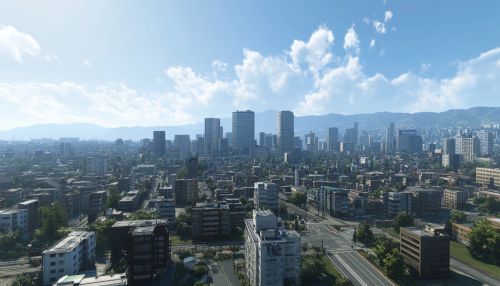Level of Detail: Difference between revisions
(Created page with "== Level of Detail == The concept of "Level of Detail" (LOD) is a fundamental principle in various fields such as computer graphics, geographic information systems (GIS), and urban planning. It refers to the amount of detail or complexity present in a representation of an object, scene, or dataset. The level of detail can be adjusted to optimize performance, manage resources, and achieve specific objectives depending on the context in which it is applied. <div class='o...") |
No edit summary |
||
| Line 3: | Line 3: | ||
The concept of "Level of Detail" (LOD) is a fundamental principle in various fields such as computer graphics, geographic information systems (GIS), and urban planning. It refers to the amount of detail or complexity present in a representation of an object, scene, or dataset. The level of detail can be adjusted to optimize performance, manage resources, and achieve specific objectives depending on the context in which it is applied. | The concept of "Level of Detail" (LOD) is a fundamental principle in various fields such as computer graphics, geographic information systems (GIS), and urban planning. It refers to the amount of detail or complexity present in a representation of an object, scene, or dataset. The level of detail can be adjusted to optimize performance, manage resources, and achieve specific objectives depending on the context in which it is applied. | ||
[[Image:Detail-98063.jpg|thumb|center|High-resolution cityscape with varying levels of detail in buildings and streets.|class=only_on_mobile]] | |||
[[Image:Detail-98064.jpg|thumb|center|High-resolution cityscape with varying levels of detail in buildings and streets.|class=only_on_desktop]] | |||
=== Computer Graphics === | === Computer Graphics === | ||
Latest revision as of 23:32, 21 September 2024
Level of Detail
The concept of "Level of Detail" (LOD) is a fundamental principle in various fields such as computer graphics, geographic information systems (GIS), and urban planning. It refers to the amount of detail or complexity present in a representation of an object, scene, or dataset. The level of detail can be adjusted to optimize performance, manage resources, and achieve specific objectives depending on the context in which it is applied.


Computer Graphics
In computer graphics, LOD is a technique used to manage the complexity of 3D models in real-time rendering. This is particularly important in video games, virtual reality, and simulations where computational resources are limited. The primary goal is to maintain an acceptable frame rate while rendering scenes that contain numerous objects.
Mesh Simplification
Mesh simplification is a common method for implementing LOD in 3D models. It involves reducing the number of polygons in a mesh while preserving its overall shape and appearance. Simplified meshes are used when objects are far from the camera, and more detailed meshes are used when objects are closer. This approach minimizes the computational load without significantly affecting visual quality.
Texture LOD
Texture LOD involves using different resolutions of textures based on the distance from the camera. Higher-resolution textures are used for objects close to the viewer, while lower-resolution textures are used for distant objects. This technique reduces memory usage and improves rendering performance.
Dynamic LOD
Dynamic LOD systems adjust the level of detail in real-time based on various factors such as camera position, object importance, and available computational resources. These systems can provide a more seamless and efficient rendering experience by continuously optimizing the detail level.
Geographic Information Systems (GIS)
In GIS, LOD refers to the granularity of spatial data. Different levels of detail are used to represent geographic features at various scales. For example, a country-level map might show only major cities and highways, while a city-level map would include detailed street layouts and individual buildings.
Data Generalization
Data generalization is the process of reducing the complexity of spatial data to create different levels of detail. This can involve simplifying geometries, aggregating features, and removing unnecessary details. Generalization helps to create maps that are easier to read and interpret at different scales.
Multi-Resolution Databases
Multi-resolution databases store spatial data at multiple levels of detail. These databases enable efficient querying and visualization of geographic information at various scales. Users can zoom in and out of maps seamlessly, with the appropriate level of detail being displayed automatically.
Urban Planning
In urban planning, LOD is used to represent different aspects of urban environments at varying levels of detail. This can include architectural models, infrastructure layouts, and land use patterns. LOD helps planners and stakeholders to understand and analyze urban areas more effectively.
Building Information Modeling (BIM)
Building Information Modeling (BIM) uses LOD to represent different stages of a building's lifecycle. LOD in BIM ranges from conceptual designs with basic shapes to detailed models with precise dimensions and materials. This allows for better planning, construction, and maintenance of buildings.
City Models
City models use LOD to represent urban areas at different scales. Low-detail models might show only the overall layout of a city, while high-detail models include individual buildings, roads, and other infrastructure. These models are used for various purposes, including urban analysis, simulation, and visualization.
Applications and Implications
The concept of LOD has broad applications and significant implications across various fields. By adjusting the level of detail, professionals can optimize performance, manage resources, and achieve specific objectives. Understanding and implementing LOD effectively is crucial for success in many technical and scientific domains.
